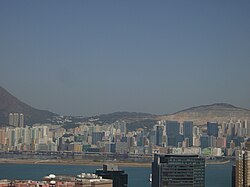New Kowloon 新九龍 | |||||||||||||||||||
|---|---|---|---|---|---|---|---|---|---|---|---|---|---|---|---|---|---|---|---|
 Eastern New Kowloon (Kowloon Bay, Kwun Tong, etc.) | |||||||||||||||||||
| Etymology: Named after the Kowloon Peninsula | |||||||||||||||||||
 Approx. location of New Kowloon (in red), as defined in a 1937 legislation, compared to the Kowloon geographical constituencies of the Legislative Council (in green); note that the newer 13/31 runway of the former Kai Tak Airport reclaimed land (also coloured in green), now considered part of New Kowloon, e.g. in lot numbers, did not exist until the 1950s. | |||||||||||||||||||
| Statutorily-defined area(s) | Kowloon / New Territories | ||||||||||||||||||
| Territory | |||||||||||||||||||
| Sovereign state | |||||||||||||||||||
| Cession of Kowloon | 1860 | ||||||||||||||||||
| Leased (as a part of the New Territories) | 1898 | ||||||||||||||||||
| Defined (from a part of the New Territories) | 1900 | ||||||||||||||||||
| Time zone | Hong Kong Time | ||||||||||||||||||
| Chinese name | |||||||||||||||||||
| Traditional Chinese | 新 九龍 | ||||||||||||||||||
| Simplified Chinese | 新 九龙 | ||||||||||||||||||
| Cantonese Yale | Sān Gáulùhng | ||||||||||||||||||
| Literal meaning | New Nine Dragons | ||||||||||||||||||
| |||||||||||||||||||
New Kowloon is an area in Hong Kong, bounded to the south by Boundary Street, and to the north by the ranges of the Eagle's Nest, Beacon Hill, Lion Rock, Tate's Cairn and Kowloon Peak. It covers the present-day Kwun Tong District and Wong Tai Sin District, and northern parts of the Sham Shui Po District and Kowloon City District.
Contents
The name of this area is[ when? ] rarely used in day-to-day life. Areas that belong to New Kowloon are usually referred to as a part of Kowloon. However, in land leases, it is common to refer to land lots in lot numbers as "New Kowloon Inland Lot number #".
